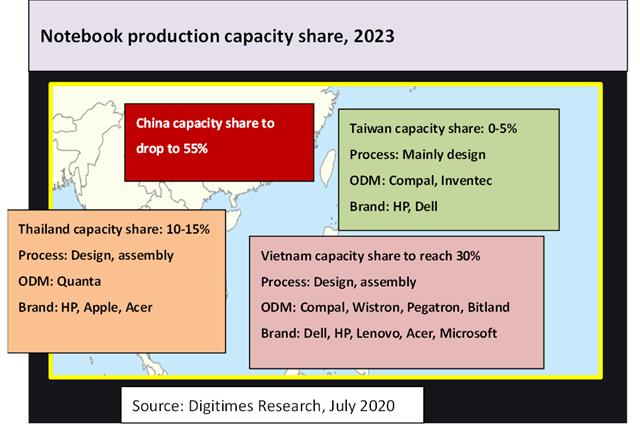According to DIGITIMES' study on the data of publicly listed companies in the automotive and electronics industries, 95 out of the 100 largest firms are based in Japan, China, Taiwan and South Korea. It can be foreseen that the process of ASEAN countries and South Asia transitioning to becoming the next production hub will be driven by Northeast Asian countries. Taiwan-based manufacturers with an OEM business focus that highlight the value of being "harmless" will be the best strategic partners to these countries on the way to starting their own high-tech industry development.
Vietnam's geographical advantage allows manufacturers to expand their logistics networks from their factories in Shenzhen, Guangdong to their production bases in northern Vietnam via land transport. Aside from Vietnam, Malaysia, Thailand and Indonesia with abundant human resources all want a piece of the pie and are stepping up efforts to attract investments from Taiwan.
According to DIGITIMES' research, Taiwan-based manufacturers produce more than 80% of the notebook computers worldwide at their factories in China. Their production bases gradually moved from the Pearl River Delta and the Yangtze River Delta to Chongqing, Chengdu and other places in the past ten years. In the face of increasing production costs in China and changes in US-China relations, they are beginning to relocate production again. It is estimated that the share of notebook computers produced in China will fall to 55% by 2023. Vietnam will take over 30% to 35% of worldwide notebook computer production and Thailand 10% to 15%. A small portion of the production will be shifted back to Taiwan.
Servers and network communication products with higher added values will mainly be produced in Taiwan. With data centers being built across the globe and information security being a major concern, the market places more trust in the products made in Taiwan. The flourishing developments of Taiwan's critical component supply chain including semiconductor and display will satisfy market demand in ASEAN countries and South Asia with products shipping out of Taiwan's Taoyuan Airport. The production system shift is underway and a logistics system shift will follow.
Further to notebook computers and mobile phones, EVs are also at the center of market attention. Although they account for a smaller than 5% share of automobile sales, the market is optimistic toward EV industry development with strong promotion efforts on the part of China and EU as well as leading US-based automakers including Tesla and Ford. Electronics are responsible for nearly 40% of a new car's total cost. The car is said to become the third computer. The total number of parts in a single car will be reduced from 30,000 to no more than 19,000. As the production process simplifies and the service system has to integrate local partners, it is believed that the trend of regional production will expand to emerging countries after the EV industry and technology mature. A growing number of electronics heavyweights are prepared to foray into the sector, which will not only reshape the industry but also spur a wave of new developments.
Joining forces with partners, Taiwan's Foxconn launched MIH, an EV software and hardware open platform. The alliance has attracted more than 1,200 companies. The initiative by the world's largest electronics manufacturer along with its announcement to make EVs for Fisker at its Wisconsin production base show that the production system expanding beyond computers and mobile phones to EVs is in the formation. ASEAN and South Asian countries will become part of the EV production system in the long run.




